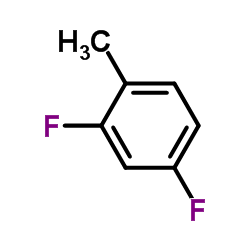2,4-Difluorotoluene

2,4-Difluorotoluene structure
|
Common Name | 2,4-Difluorotoluene | ||
|---|---|---|---|---|
| CAS Number | 452-76-6 | Molecular Weight | 128.119 | |
| Density | 1.1±0.1 g/cm3 | Boiling Point | 114.7±20.0 °C at 760 mmHg | |
| Molecular Formula | C7H6F2 | Melting Point | N/A | |
| MSDS | Chinese USA | Flash Point | 15.0±0.0 °C | |
| Symbol |

GHS02 |
Signal Word | Danger | |
|
A thymine isostere in the templating position disrupts assembly of the closed DNA polymerase beta ternary complex.
Biochemistry 44(46) , 15230-7, (2005) The high fidelity of the DNA polymerization process is critically important for the stability of the cellular genome. The role of template and incoming nucleotide base pairing in polymerase fidelity has recently been explored by the use of nucleotide isostere... |
|
|
Importance of terminal base pair hydrogen-bonding in 3'-end proofreading by the Klenow fragment of DNA polymerase I.
Biochemistry 39(10) , 2626-32, (2000) We describe studies aimed at evaluating the physical factors governing the rate of 3'-end proofreading by the Klenow fragment of E. coli DNA polymerase I. Two nonpolar deoxynucleoside isosteres containing 2,4-difluorotoluene (F) and 4-methylbenzimidazole (Z),... |
|
|
Nonpolar nucleobase analogs illuminate requirements for site-specific DNA cleavage by vaccinia topoisomerase.
J. Biol. Chem. 281(47) , 35914-21, (2006) Vaccinia DNA topoisomerase forms a covalent DNA-(3'-phosphotyrosyl)-enzyme intermediate at a specific target site 5'-C(+5)C(+4)C(+3)T(+2)T(+1)p downward arrow N(-1) in duplex DNA. Here we study the effects of nonpolar pyrimidine isosteres difluorotoluene (F) ... |
|
|
Molecular moment similarity between several nucleoside analogs of thymidine and thymidine. sil@watson.ibm.com.
J. Biomol. Struct. Dyn. 16(6) , 1169-75, (1999) Molecular moment descriptors of the shape and charge distributions of twenty five nucleoside structures have been examined. The structures include thymidine as well as the difluorotoluene nucleoside analog which has been found to pair efficiently with adenine... |
|
|
Quantum-chemical ab initio study on the adenine-difluorotoluene complex--a mimic for the adenine-thymine base pair.
J. Biomol. Struct. Dyn. 15(3) , 619-24, (1997) Recent experiments have shown that difluorotoluene (F), a nonpolar isostere for thymine (T), codes efficiently and specifically for adenine (A) in DNA replication. F has almost the same shape as thymine but it is unable to form conventional hydrogen bonds wit... |
|
|
Solution structure of a DNA duplex containing a replicable difluorotoluene-adenine pair.
Nat. Struct. Biol. 5(11) , 954-9, (1998) A nonpolar aromatic nucleoside derivative based on 2,4-difluorotoluene (F), a non-hydrogen bonding shape analog of thymidine, was recently shown to be replicated against adenine with high efficiency and fidelity. This led to the suggestion that geometric matc... |
|
|
Aromatic Nonpolar Nucleosides as Hydrophobic Isosteres of Pyrimidine and Purine Nucleosides.
J. Org. Chem. 59(24) , 7238-7242, (1994) Described are the design, synthesis, and structures of three nonpolar nucleoside isosteres to be used as probes of noncovalent bonding in DNA and as isosteric replacements for the natural nucleosides in designed nucleic acid structures. Reaction of substitute... |
|
|
The difluorotoluene debate--a decade later.
Chem. Commun. (Camb.) (35) , 3665-75, (2006) 2,4-Difluorotoluene is unusual among hydrofluorocarbons because it is shaped like the DNA base thymine. It was first synthesised as a nucleotide analogue and incorporated into DNA a decade ago. Although it is a nonpolar molecule, it was found to be replicated... |
|
|
Discrimination among individual Watson-Crick base pairs at the termini of single DNA hairpin molecules.
Nucleic Acids Res. 31(4) , 1311-8, (2003) Nanoscale alpha-hemolysin pores can be used to analyze individual DNA or RNA molecules. Serial examination of hundreds to thousands of molecules per minute is possible using ionic current impedance as the measured property. In a recent report, we showed that ... |
|
|
Novel modifications in RNA.
ACS Chem. Biol. 7(1) , 100-9, (2012) The past several years have seen numerous reports of new chemical modifications for use in RNA. In addition, in that time period, we have seen the discovery of several previously unknown naturally occurring modifications that impart novel properties on the pa... |